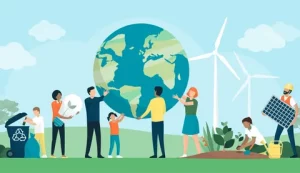In recent decades, the urgency of addressing climate change has become increasingly apparent. As the scientific community continues to underscore the dire consequences of inaction, global climate policy has emerged as a crucial arena for international cooperation. This article delves into the future of global climate policy, examining key trends, challenges, and potential pathways forward.
The Paris Agreement: A Foundation for Future Action

The Paris Agreement, adopted in 2015, represents a landmark in global climate policy. It is the first legally binding international treaty that brings all nations together in a shared commitment to limit global warming to well below 2 degrees Celsius above pre-industrial levels, with efforts to limit the increase to 1.5 degrees Celsius. The agreement’s framework of Nationally Determined Contributions (NDCs) allows countries to set their own targets for reducing greenhouse gas emissions, fostering a sense of ownership and accountability.
However, while the Paris Agreement provides a robust foundation, its success hinges on the ambition and implementation of these NDCs. As we look to the future, the focus will likely shift towards enhancing these commitments, ensuring transparency, and fostering collaboration among nations.
Strengthening Commitments: The Role of NDCs
One of the critical aspects of the future of global climate policy will be the periodic review and strengthening of NDCs. The Paris Agreement stipulates that countries must update their NDCs every five years, with each iteration reflecting a progression beyond previous targets. This mechanism is designed to ratchet up ambition over time.
In practice, this means that countries will need to adopt more aggressive measures to curb emissions, enhance carbon sinks, and adapt to the impacts of climate change. For instance, transitioning to renewable energy sources, investing in energy efficiency, and promoting sustainable land use practices will be essential components of future NDCs. Additionally, the integration of climate considerations into broader economic and development policies will be crucial for achieving long-term sustainability.
The Role of Technology and Innovation
Technological advancements and innovation will play a pivotal role in shaping the future of global climate policy. The development and deployment of clean energy technologies, such as solar, wind, and advanced nuclear power, will be instrumental in reducing greenhouse gas emissions. Furthermore, innovations in energy storage, smart grids, and electric vehicles will enhance the efficiency and resilience of energy systems.
Carbon capture and storage (CCS) technologies also hold promise for mitigating emissions from industries that are difficult to decarbonize, such as cement and steel production. Additionally, nature-based solutions, including reforestation, afforestation, and soil carbon sequestration, offer cost-effective and scalable options for enhancing carbon sinks.
The future of global climate policy will also depend on the ability to leverage digital technologies, such as artificial intelligence, big data, and the Internet of Things (IoT), to monitor emissions, optimize resource use, and improve climate resilience. For example, precision agriculture can help farmers adapt to changing climate conditions, while smart city initiatives can reduce urban emissions and enhance quality of life.
Climate Finance: Mobilizing Resources for Action
Achieving the goals of the Paris Agreement will require substantial financial investments. Climate finance, which involves the mobilization of public and private funds to support climate mitigation and adaptation efforts, will be a cornerstone of future global climate policy.
Developed countries have committed to mobilizing $100 billion per year by 2020 to support climate action in developing countries. However, meeting this target has proven challenging, and the actual amounts mobilized have fallen short. Moving forward, it will be essential to enhance transparency, accountability, and predictability in climate finance flows.
Innovative financing mechanisms, such as green bonds, climate funds, and public-private partnerships, will be crucial for scaling up investments. Additionally, aligning financial flows with climate goals, as outlined in Article 2.1(c) of the Paris Agreement, will require systemic changes in the financial sector, including the integration of climate risks into investment decisions and the promotion of sustainable finance practices.
Equity and Justice: Ensuring Inclusive Climate Policy
Equity and justice considerations will be central to the future of global climate policy. Climate change disproportionately affects vulnerable populations, including low-income communities, indigenous peoples, and small island developing states. Therefore, ensuring that climate policies are inclusive and equitable will be essential for fostering global solidarity and achieving sustainable outcomes.
The principle of “common but differentiated responsibilities and respective capabilities” (CBDR-RC) underpins the Paris Agreement, recognizing that countries have different historical contributions to climate change and varying capacities to address it. Future climate policies will need to operationalize this principle by providing targeted support to those most affected and ensuring that the transition to a low-carbon economy is just and inclusive.
The Role of Non-State Actors

While national governments play a central role in shaping global climate policy, non-state actors, including cities, businesses, civil society organizations, and indigenous communities, are increasingly recognized as vital contributors to climate action. Initiatives such as the Global Covenant of Mayors for Climate & Energy and the Science-Based Targets initiative demonstrate the significant impact that non-state actors can have in driving emissions reductions and enhancing resilience.
The future of global climate policy will likely see a greater emphasis on multi-stakeholder collaboration, with non-state actors playing a complementary role to national governments. This approach can foster innovation, enhance policy implementation, and build broader societal support for climate action.
Conclusion: Navigating the Path Ahead
The future of global climate policy is at a critical juncture. While the Paris Agreement provides a solid foundation, achieving its goals will require enhanced ambition, technological innovation, substantial financial investments, and a commitment to equity and justice. By fostering international cooperation and leveraging the contributions of all stakeholders, the global community can navigate the path towards a sustainable and resilient future.










